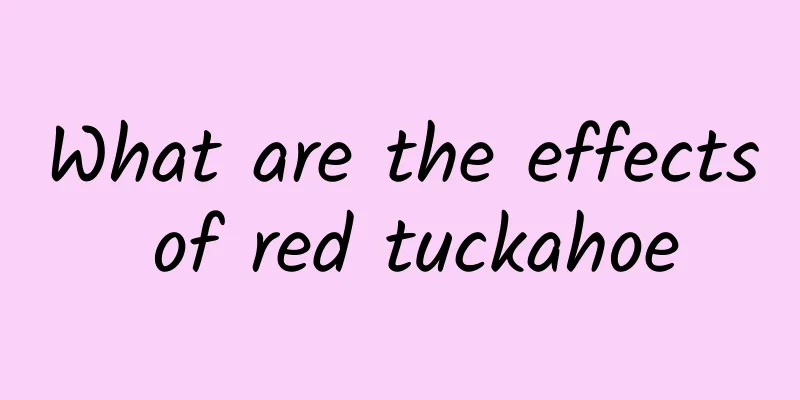What are the effects of red tuckahoe

|
In the eyes of many people, the drug red tuckahoe is very unfamiliar. However, we cannot just ignore the herb Red Poria cocos just because people don’t know much about it. If we want to make better use of the red tuckahoe, we need to understand its effects. So what are the effects of red Poria cocos? Let’s see how the editor answers this question. Poria cocos is sweet, mild and neutral in nature, and enters the heart, lung and spleen meridians. It has the effects of dissipating dampness and promoting diuresis, strengthening the spleen and stomach, and calming the mind. It can cure symptoms such as difficulty in urination, edema, cough due to phlegm and fluid, vomiting, nausea, diarrhea, spermatorrhea, stranguria, palpitations, and forgetfulness. The diuretic effect of Poria cocos is achieved by strengthening the spleen and lung functions, which is different from other Chinese medicines that directly promote diuresis. Ling Gui Zhu Gan Tang, Si Jun Zi Tang, and Si Ling Tang are all commonly used prescriptions that contain Poria cocos. Red Poria cocos effects: 1. Diuretic effect Diuretic effect: 0.5g/Kg of 25% Poria cocos alcohol extract was injected intraperitoneally into normal rabbits, which produced a diuretic effect. Experiments using adrenalectomized rats have shown that the diuretic effect is related to the impact on the absorption of Na+ in the renal tubules. It has been reported that the aqueous extract and alcohol extract of Poria cocos showed almost no diuretic effect after oral administration to rabbits, rats, mice, etc., and there was no diuretic effect when the decoction was injected intravenously in a chronic experiment on dogs with ureteral fistula. However, there are also reports that chronic experiments on conscious rabbits have proved that Poria cocos does have a diuretic effect, and ash control has proved that its diuretic effect is not due to potassium salts, but to the effects of other components other than potassium salts. The hot water extract and water-soluble polysaccharide components of Poria cocos have no significant effect on normal rabbits. If Poria cocos is combined with ginger and licorice, the urine volume will increase steadily from one hour after administration, and the effect will continue thereafter. In clinical practice, Poria cocos is used in combination with Atractylodes macrocephala, ginger, etc. to treat symptoms such as chronic nephritis. The urine volume increases significantly one hour after administration. It is suggested that in terms of diuretic effect, compound medicine can produce more sustained effect than single medicine. The mechanism of Poria's diuretic effect has not yet been elucidated. Some people compared Poria cocos ash with 25% Poria cocos alcohol extract. The results showed that the latter showed a diuretic effect, while the former had no effect, indicating that Poria cocos contains special diuretic ingredients. In an experiment using adrenalectomized rats, injection of deoxycorticosterone combined with the use of 30% Poria cocos decoction increased urine volume, urinary sodium and potassium excretion compared to deoxycorticosterone alone. Therefore, it is believed that Poria cocos does not have an anti-deoxycorticosterone effect, but is related to affecting the reabsorption of sodium ions by the renal tubules. 2. Sedative effect Intraperitoneal injection of Poria decoction into mice can significantly reduce their spontaneous activity and counteract the excessive excitement of mice caused by caffeine; it has a significant synergistic effect on the anesthetic effect of sodium pentobarbital. Poria cocos can enhance the central nervous system inhibitory effect of thiopental sodium on mice and significantly prolong the anesthesia time. Decoctions, especially Fushen injection, have a sedative effect on animals. 3. Effects on the cardiovascular system In the perfusion experiments on isolated hearts of marmots, toads and edible frogs, the water extract, ethanol extract and ether extract of Poria cocos can all enhance myocardial contractility and increase heart rate. Poria cocos water extract and ethanol extract have hypoglycemic effects on rabbits. Poria water, ethanol and ether extracts all enhance the contraction and accelerate the heart rate of isolated frog hearts. 4. Effects on the digestive system Poria cocos has a significant protective effect on liver damage in mice caused by carbon tetrachloride. It can significantly reduce the activity of alanine aminotransferase and prevent liver cell necrosis. Poria cocos extract has a direct relaxing effect on the isolated intestinal tract of rabbits, reducing the contraction amplitude and tension of smooth muscle, and has an inhibitory effect on ulcers caused by pyloric ligation in rats. It can also reduce gastric juice secretion and free acid content. 5. Other functions Oral administration of Poria decoction can significantly increase the rosette formation rate and the phytohemagglutinin-induced lymphocyte transformation rate. Poria polysaccharide has the functions of resisting thymus atrophy, spleen enlargement and inhibiting tumor growth. Oral administration of Poria polysaccharide can enhance the phagocytic function of mouse macrophages, increase the number of ANAE-positive lymphocytes, and significantly increase the number of antibody-secreting cells in the mouse spleen. Poria polysaccharide can also accelerate the recovery of leukocytopenia in rats caused by cyclophosphamide. Carboxymethyl Poria polysaccharide also has multiple physiological activities such as immunomodulation, liver protection and enzyme reduction, indirect anti-virus, induction and promotion of interferon, reduction of radiation side effects, induction and promotion of leukocyte regulatory factor, etc., with no adverse toxic and side effects. After understanding the effects of red tuckahoe, we can use this medicine when necessary in our lives. At the same time, we also know that the drug red tuckahoe has good skin care effects, so we can take care of our skin by making some skin care masks ourselves. Red Poria cocos can also be made into some medicinal foods, and understanding these is very helpful for our body. |
<<: How long should I boil Chinese medicine?
>>: Can eating Poria cocos whiten your skin?
Recommend
What are the medicinal values of Lingzhi?
Nowadays, people are more concerned about health....
[Smart Farmers] Picture Book | “Crab Encounter” Spectacular: What Do Ornamental Crabs Look Like?
Picture Book | “Crab Encounter” Spectacular: What...
The efficacy and function of rock shanzhi
Yanshanzhi is a famous traditional commonly used ...
The efficacy and function of carp intestines
Traditional Chinese medicine has a history of tho...
How to treat phlegm-damp constitution with Chinese medicine?
Phlegm-damp constitution is a very common constit...
The efficacy and function of Panax notoginseng
White-backed Panax notoginseng is rich in nutriti...
The demon boy moves to the deep sea! 30 minutes of power = 21 times the Asian sandstorm?
Nezha 2 has swept the world at the box office, an...
Is lotus root starch a healthy food? How did lotus root starch become a bowl of paste?
Lotus root powder is crystal clear, delicate, fra...
The man was found to be driving under the influence even though he had not drunk any alcohol. It turned out that he had this bacteria in his body! The treatment method is cruel...
One late night in April 2020, in the small town o...
1056 seconds! China's "artificial sun" EAST sets a new record for the longest discharge
On the evening of December 30, 2021, the world re...
The hotter the foot bath water, the better? The truth is——
Review expert: Wang Xuejiang, professor of pathop...
The efficacy and function of Sanhexiang
Shanhexiang is one of the common traditional Chin...
The efficacy and function of June snow leaves
In today's society, health preservation seems...
The efficacy and function of cypress
Diseases require improvement through medicine. Di...
The efficacy and function of mustard seeds
Mustard seed is a medicinal ingredient that can t...









